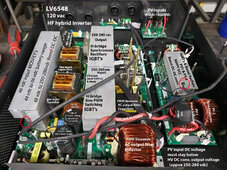Hey, I found that my two LV 6548 split phase inverters have been hitting their over Temp protection when running high loads for a short period. Currently it’s winter here and my garage is fairly cool. I’ve seen a lot of other posts about hooking up a small AC unit or fans to bring down the temperature during high loads.
My plan is to hook up a fan to the upper draw areas of the inverters. Not sure whether I’m going to recirculate garage air or pull in from outside.
Rather than having to turn the fan on and off manually during high loads I would like to hook up a smart switch that’s controlled by a temperature probe, that way when temperatures increase the switch will turn the fan on bring the temperature down and then turn off again.
I would like to put the temperature probe in the inverter close to its current internal probe. I’ve got a service manual for the LV 6548 and can’t seem to see reference to it. I’ve watched a few YouTube teardown videos, but I’m having trouble finding where the best spot to place this probe would be.
Any direction would be appreciated as to where to find it, or any experience in terms of fan placement for reducing overheating.
Thanks
My plan is to hook up a fan to the upper draw areas of the inverters. Not sure whether I’m going to recirculate garage air or pull in from outside.
Rather than having to turn the fan on and off manually during high loads I would like to hook up a smart switch that’s controlled by a temperature probe, that way when temperatures increase the switch will turn the fan on bring the temperature down and then turn off again.
I would like to put the temperature probe in the inverter close to its current internal probe. I’ve got a service manual for the LV 6548 and can’t seem to see reference to it. I’ve watched a few YouTube teardown videos, but I’m having trouble finding where the best spot to place this probe would be.
Any direction would be appreciated as to where to find it, or any experience in terms of fan placement for reducing overheating.
Thanks



